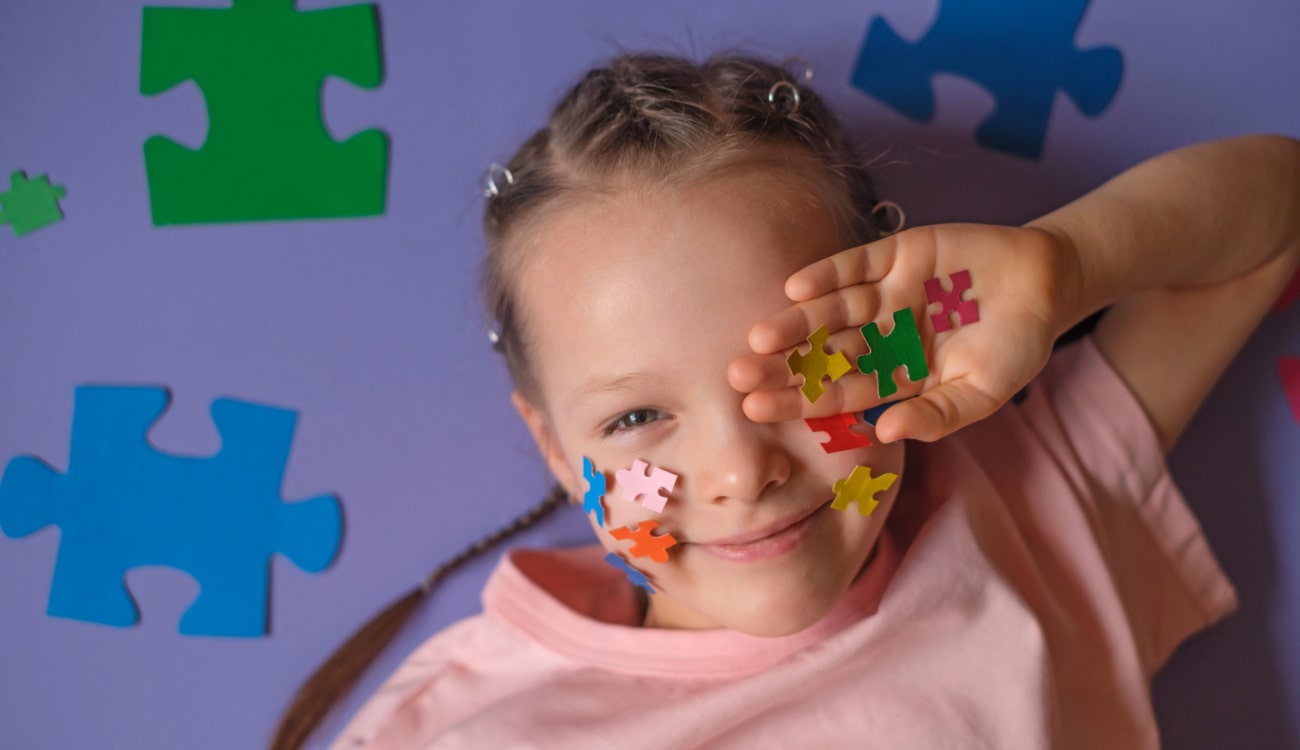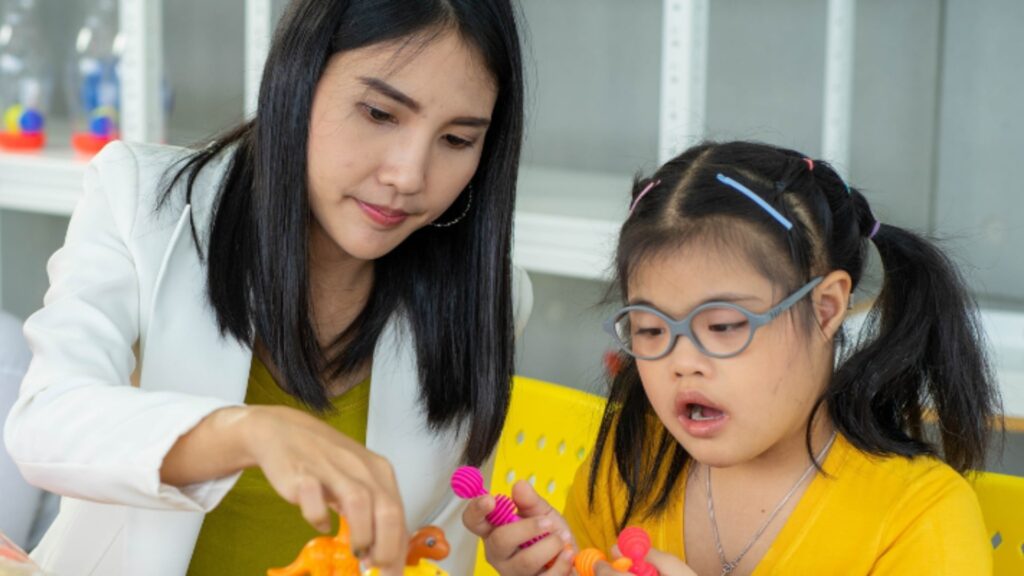What is Autism?
Autism, or autism spectrum disorder (ASD), is a lifelong condition that affects how people experience the world and interact with others. It’s a spectrum, meaning it looks different for everyone, and there’s no one-size-fits-all description. Some people with autism might find social situations tricky, while others might have a deep focus or talent in a specific area, like maths or art. It’s important to remember that everyone with autism is unique, and the way they experience the world can vary widely.
Autism tends to show up in early childhood, with signs often appearing before the age of 3, though sometimes it’s not immediately clear. Common characteristics can include challenges with communication, both verbal and non-verbal, and difficulty understanding social cues. Many people on the spectrum prefer routine and can feel overwhelmed by changes, while others might have sensitivities to sounds, lights, or textures that most people don’t notice.
But autism is not just a list of challenges. It can also come with strengths. Many people with autism have an incredible attention to detail and the ability to think in ways that others might not. The way they approach problems can be incredibly creative and innovative. It’s all about recognising that autism is part of a person’s identity, not something that needs to be fixed.
The important thing to remember is that there is no ‘right’ or ‘wrong’ way to experience autism. It’s a broad spectrum, and everyone’s needs and abilities will be different. With the right support and understanding, people with autism can lead fulfilling lives, but society needs to be more inclusive and open-minded about differences.
So, next time you hear the word ‘autism’, think beyond the stereotypes. It’s not something that defines a person entirely, but rather a part of who they are, with unique experiences, challenges, and strengths that deserve recognition and respect.
We Help Children With Autism
1 in 36 children are affected by autism. We provide the support groups, social skills programs, and inclusive events that they need to develop. Donate today and help them get the help they deserve!
What Are the Signs of Autism?
When it comes to autism, the signs can look quite different from person to person, which is why it’s called a ‘spectrum’. Some people might show very noticeable signs, while others may have more subtle traits that are harder to spot. That said, there are a few common symptoms that tend to appear, especially in early childhood.
One of the most noticeable things is difficulty with social interaction. People with autism might struggle to understand social cues, like body language or tone of voice. They might find it hard to start or maintain conversations, and sometimes they don’t pick up on when others want to take a turn speaking or might feel uncomfortable in group settings. This doesn’t mean they don’t want to interact, they just might not know how.
Another common symptom is a preference for routine. Many people with autism feel more comfortable when things are predictable, and changes in routine can be stressful or overwhelming. This could be something as small as a different route to school or a change in daily plans, but it can feel like a big shift to someone on the spectrum.
Sensory sensitivities are also a big part of autism for many people. Some might be highly sensitive to lights, sounds, or certain textures, while others may not feel pain or temperature in the same way. This can make everyday situations – like going to a busy shopping centre or wearing a certain fabric – feel overwhelming or uncomfortable.
Repetitive behaviours, such as repeating the same actions or phrases, are also common. These can serve as a way of coping with anxiety or providing comfort in situations that might feel uncertain. These behaviours might be seen as ‘stimming’, where someone engages in repetitive movements or sounds to help them focus or self-regulate.
It’s also important to note that autism can come with intense interests or areas of focus. Some people on the spectrum might have a deep passion for a particular subject, like trains, maths, or history. This can be a wonderful strength, as it can lead to expertise and a unique way of viewing the world, but it can also mean that the person may struggle to focus on other things.
Not everyone with autism will experience all these symptoms, and the severity can vary a lot. Some people may have very mild traits, while others may face more significant challenges. And while these symptoms can be part of autism, they don’t define a person. Everyone is different and has their own strengths and capabilities.
Ultimately, understanding autism isn’t about focusing solely on the symptoms, but recognising that it’s a part of someone’s identity. With the right support, people with autism can thrive and show the world what they’re capable of. It’s all about seeing the person, not just the condition.
Can Autism Be Cured?
The simple answer is no – autism can’t be cured. Autism isn’t a disease or an illness, it’s a neurodevelopmental condition that affects how a person perceives and interacts with the world. It’s a part of who they are, and it lasts for life. Saying autism can be cured is like saying you can ‘cure’ someone’s personality or the way they think. It’s just not how it works.
This doesn’t mean that people with autism can’t lead fulfilling, successful lives. The goal for those with autism isn’t to ‘fix’ them, but to help them develop skills and strategies that allow them to thrive in the world around them. Early intervention, tailored support, and understanding from friends, family, and society can make a huge difference in helping someone with autism to reach their full potential.
There are various therapies and interventions that can help with things like communication, social skills, and managing sensory sensitivities. These can be incredibly helpful in supporting individuals to cope with daily challenges and feel more confident. But these approaches aren’t about changing the person – they’re about helping them navigate a world that isn’t always designed with them in mind.
It’s also important to note that autism is a spectrum. Some people might need a lot of support, while others might only need a little. And many people with autism have strengths and talents that can really shine once they’re given the right support. The idea is not to try and make someone ‘neurotypical’ or take away their identity, but to appreciate their unique way of being and help them thrive.
So, instead of thinking about a ‘cure’, it’s more helpful to focus on acceptance, understanding, and making sure that people with autism have the opportunities and support they need to live happy, independent lives. The world can be overwhelming and difficult to navigate at times, but with the right resources and an inclusive environment, everyone, regardless of where they are on the autism spectrum, can contribute in meaningful ways.
Can Autistic People Live A Normal Life? Toby’s Story
Our personal experience with autism starts with our son, Toby. I’ve known for a long time that something wasn’t quite right with his development. I first started to feel this gut instinct when he was around 9 months old. Toby was quite delayed with a lot of milestones, and I noticed he didn’t give much eye contact, which had me worrying. He also started stimming early on. At the time, I didn’t know much about stimming, but I could tell that his hand flapping and leg movements weren’t something I’d seen in other children his age.
Even though I had all these thoughts and concerns, I didn’t do anything about them until he turned 2. Before his 2-year developmental review, a lot of our family thought I was overreacting, and that there wasn’t really anything wrong. But deep down, I knew there was something more going on with Toby – I just couldn’t shake that feeling.
At his 2-year check, the health visitor came round to do some developmental tests, and as soon as she saw Toby, she knew exactly what I’d been talking about all along. She told me straight away that Toby needed to be placed on the umbrella pathway for further assessments and that he needed to see speech and language therapists. Hearing her say that was such a relief. It was the first time someone really confirmed what I’d been thinking wasn’t just in my head. I can’t thank her enough for all the time, effort, and reassurance she gave us. Without her support, we wouldn’t be where we are today.
After that review, Toby’s appointments started. We saw a speech and language therapist who suggested we try sign language with him. To be honest, Toby never really took to it – he didn’t give us the eye contact we needed to engage him with it. That said, I know it works for some children, and I would absolutely recommend trying it if it’s suggested for your child. In Toby’s case, he much preferred using his autism picture communication cards, and that’s how he communicates with us now. I actually ended up making my own communication cards that you can download and print for FREE here – Free Autism Communication Cards.
Along the way, we’ve worked with so many professionals – child psychologists, specialist play therapists, paediatricians, and others who have all been involved in Toby’s care. It’s been a bit of a rollercoaster, but we’ve been so lucky to have such a supportive team behind us.
Now, Toby is waiting for his diagnosis, and we’ve been told it won’t be much longer. They’ve got all the information they need from the professionals involved in his care, so it’s just a matter of time. And on top of that, we’ve been thrilled to find out that Toby’s been accepted into a specialist school for September, which is a huge weight off our shoulders. We’re over the moon about it!
It’s been a long journey, and we’re still learning, but knowing Toby is getting the right support is honestly the best feeling. We’re incredibly proud of him and excited about what the future holds for him.
What is the Difference Between Autism and ADHD?
What Is Autism and is it different to ADHD? Autism and ADHD (attention deficit hyperactivity disorder) are two conditions that are often mentioned together, but they are quite different in terms of how they affect a person. While both can affect behaviour, focus, and social interactions, they each have their own unique characteristics. It’s important to understand these differences, especially as many people may have both conditions at the same time – something known as a ‘comorbidity’.
Autism, or autism spectrum disorder (ASD), is a neurodevelopmental condition that affects how a person communicates, interacts, and processes the world around them. The key traits of autism often include difficulties with social interaction, sensitivity to sensory input (like bright lights or loud noises), and a preference for routines or specific interests. People with autism might find it challenging to understand social cues, and they might struggle with things like eye contact or reading facial expressions, but this doesn’t mean they don’t want to connect with others – they simply experience the world differently.
ADHD, on the other hand, is primarily characterised by difficulties with attention, impulsivity, and hyperactivity. People with ADHD might have trouble staying focused on tasks, may act without thinking, and can feel restless or constantly on the go. They might find it hard to organise their thoughts or follow through on tasks, which can impact school, work, and social life. While people with autism can also struggle with attention and focus, ADHD’s core symptoms are more about being unable to sit still, concentrate, or regulate impulses.
One key difference is in how social interactions are impacted. People with autism may find it challenging to understand social norms and read other people’s emotions. However, this doesn’t mean they lack interest in forming relationships; they just might struggle with the social side of things. In contrast, people with ADHD may be socially outgoing and seek out social interactions, but their impulsivity and difficulty focusing can sometimes lead to misunderstandings or frustrations in relationships.
Another difference is how each condition affects sensory experiences. Many people with autism have heightened or diminished sensory sensitivities, meaning they might be overwhelmed by certain lights, sounds, or textures, or conversely, they might not notice certain sensations. ADHD, on the other hand, doesn’t generally involve sensory issues, though people with ADHD may get distracted by sensory stimuli in their environment.
Despite these differences, it’s possible for someone to have both autism and ADHD. In fact, some of the traits overlap, like difficulty with attention or regulating behaviour. However, treatment and support strategies might vary depending on which condition is more prominent. For instance, while ADHD is often treated with medication to help manage focus and impulsivity, autism-related interventions might focus more on improving communication, social skills, and managing sensory sensitivities.
Ultimately, both autism and ADHD are unique, and it’s important not to confuse the two. Understanding the differences and similarities helps us better support those who live with either condition – or both. The key takeaway is that, while the symptoms may look similar in some cases, each person’s experience is different and should be respected for its individuality.
So What Is Autism?
What is autism? Autism is a lifelong neurodevelopmental condition that shapes how a person experiences the world. Autism is a spectrum, meaning everyone’s journey is different, with their own strengths and challenges. With understanding, support groups, and inclusivity, autistic individuals can thrive and contribute in meaningful ways.
We Help Children With Autism
1 in 36 children are affected by autism. We provide the support groups, social skills programs, and inclusive events that they need to develop. Donate today and help them get the help they deserve!






0 Comments